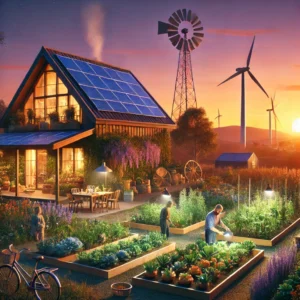Living A Self Sustainable Lifestyle

Living a Self Sustainable Lifestyle: Key Practices and Benefits
In today’s fast-paced world, you might find yourself becoming more aware of the impact you have on the environment and the benefits of living sustainably. A self-sustainable lifestyle is one of the best ways to align your daily life with your values of conservation and responsibility. Imagine being less reliant on the grid, producing your own food, and minimizing waste. All these aspects lead to a more fulfilling and environmentally-friendly life!
Key Practices for Self-Sustainability
Embracing a self-sustainable lifestyle involves several key practices that can easily be integrated into your daily routine. Here are some essential habits to consider:
- Grow Your Own Food: Start a vegetable or herb garden at home. Not only does it reduce your grocery bills, but home-grown produce has better taste and nutrient value.
- Rainwater Harvesting: Collect rainwater to use in your garden or for cleaning. It reduces your water bill and is an excellent way to conserve this precious resource.
- Solar Energy: Install solar panels to harness renewable energy. Not only does this reduce your carbon footprint, but it may also generate savings on your electricity bills.
- Composting: Recycle your kitchen scraps and garden waste into nutrient-rich compost. This practice reduces landfill waste and enriches your soil.
- Minimalism: Adopt a minimalist lifestyle by decluttering your home and only keeping what you genuinely need. This reduces waste and encourages conscious consumption.
- Natural Cleaning Products: Make your own cleaning supplies using vinegar, baking soda, and essential oils. This is not only healthier for you but also for the planet.
- Reduce, Reuse, Recycle: Follow the three R’s diligently. Focus on reducing the waste you create, reusing items, and recycling as much as possible.
Benefits of a Self-Sustainable Lifestyle
Living sustainably brings a wealth of benefits. Understanding these can motivate you to make more responsible choices:
| Benefit | Description |
|---|---|
| Environmental Impact | Lowering your carbon footprint and preserving natural resources helps protect the planet. |
| Financial Savings | Reducing dependency on utility companies and eliminating purchases leads to lower monthly expenses. |
| Health Benefits | Growing your own food means fresh, organic produce, which is better for your physical health. |
| Community Building | Engaging with neighbors through shared gardening or recycling initiatives encourages a sense of connection. |
Getting Started on Your Journey
The path to self-sustainability can feel overwhelming, but taking small steps makes it more manageable. Start with one or two practices that resonate with you.
Consider visiting [The National Sustainable Agriculture Information Service](https://attra.ncat.org/) to explore resources tailored for sustainable living. You’ll find guides, articles, and tips on how to grow your own food and use sustainable practices effectively.
Another valuable resource is [The Permaculture Research Institute](https://www.permaculturenews.org/), which provides in-depth information on creating self-sustaining ecosystems in your backyard.
Engage and Adapt
As you embark on your journey, remember to engage with others who are also interested in living sustainably. Joining local groups or online communities can provide inspiration and support as you adapt to a self-sustainable lifestyle. Don’t hesitate to share your experiences, ask questions, and learn from the journeys of others.
Ultimately, adopting a self-sustainable lifestyle is not just about the individual; it’s a collective effort toward a healthier planet. By influencing your immediate surroundings, you can contribute to a larger movement of conservation and ecological responsibility.
Start today! Even the smallest changes can lead to a more sustainable and rewarding lifestyle.
Affordable Ways to Start Your Self Sustainability Journey
Starting your self-sustainability journey doesn’t have to break the bank. Many people think that living sustainably requires a lot of money or extensive knowledge, but that’s far from the truth. You can take small, affordable steps to live a self-sustainable lifestyle. From growing your own food to reducing waste, each action makes a difference. Here are some budget-friendly ways to begin.
Start a Small Garden
Even if you have limited space, starting a garden can be incredibly rewarding. Container gardening is an excellent option for those with small patios or balconies. Here’s how you can do it:
- Choose Easy-to-Grow Plants: Start with herbs like basil, mint, or parsley. Vegetables like tomatoes, radishes, and peppers are also great for beginners.
- Use Recycled Containers: Old buckets, jars, or any container can turn into a planting pot.
- Compost Kitchen Scraps: You can create nutrient-rich compost with food scraps like vegetable peels and coffee grounds.
For more tips on gardening, visit Gardeners.com.
Reduce, Reuse, and Recycle
Before buying new items, consider what you can reduce, reuse, or recycle. This not only saves money but also minimizes waste. Here are some effective strategies:
- Reduce: Cut down on unnecessary purchases, especially single-use items.
- Reuse: Find creative ways to use old items. For example, glass jars can serve as storage containers.
- Recycle: Familiarize yourself with your community’s recycling guidelines to ensure proper disposal.
Websites like Organic Lifestyle Magazine offer valuable insights into sustainable living and recycling.
Shop Smart
Conscious consumerism is key to a self-sustainable lifestyle. Here are some strategies to shop more sustainably while being budget-friendly:
- Buy Local: Seek out local farmers markets or food co-ops for fresh produce. This often supports local economies and reduces transportation emissions.
- Choose Bulk: Purchasing grains, nuts, and spices in bulk can save money and reduce packaging waste.
- Opt for Second-Hand: Thrift shops and online marketplaces are great places for clothes and household goods.
Embrace Alternative Energy Sources
While large solar panels can be expensive, there are affordable ways to utilize alternative energy:
- Solar-Powered Gadgets: Consider investing in solar chargers for your electronics or solar string lights for outdoor areas.
- Energy-Efficient Appliances: Replace old appliances with energy-efficient models over time to save on utility bills.
Every small change contributes to a larger impact on your energy consumption. Learn more about affordable solar options at Energy.gov.
Cook from Scratch
Cooking your meals can be much cheaper than regularly eating out, and it also allows you to control ingredients:
- Meal Prep: Prepare meals in advance to save time and reduce food waste.
- Learn to Preserve: Canning or freezing seasonal produce can help you enjoy it year-round.
Community Engagement
Getting involved in your community can lead to sustainable practices that save money:
- Join a Local Gardening Group: Many communities have co-op gardens where you can share resources and knowledge.
- Attend Workshops: Look for local classes on sustainable practices, from composting to cooking.
For community resources, visit Meetup.com to find local groups focused on sustainability.
Living a self-sustainable lifestyle is achievable and can be done affordably with these strategies. As you incorporate these practices into your daily routine, you’ll not only save money but also contribute positively to the environment. Every small step brings you closer to a more sustainable life.
The Role of Gardening in Achieving Self Sustainability
Gardening plays a crucial role in achieving self-sustainability and is an ideal practice for those who wish to lessen their dependency on commercial food systems. By growing your own fruits, vegetables, and herbs, you can not only enhance your diet but also contribute positively to the environment. Engaging in this rewarding activity allows you to take control of your food source, reduce your carbon footprint, and increase biodiversity in your local area.
The Benefits of Gardening for Self-Sustainability
Gardening offers numerous advantages that align perfectly with a self-sustainable lifestyle. Below are some key benefits to consider:
- Fresh Produce: Growing your own food ensures that you have access to fresh, nutritious produce right from your backyard. This reduces the need for store-bought items, which often come with high transportation emissions.
- Cost-effective: Cultivating your own garden can lead to significant savings on grocery bills, especially when producing seasonal vegetables and fruits.
- Environmental Impact: Home gardening reduces reliance on industrial agriculture, which is a major contributor to environmental degradation through pesticide use, monoculture, and deforestation.
- Food Security: Growing your own food creates a sense of security over your food supply. In uncertain times, having a home garden can be a crucial resource.
- Health Benefits: Gardening encourages physical activity and mindfulness. Spending time outdoors and engaging with nature promotes mental and physical well-being.
How to Start Your Own Sustainable Garden
Starting a garden can be both exciting and fulfilling. Here are some steps to help you get started:
- Choose the Right Location: Select a spot with ample sunlight, good soil quality, and convenient access to water.
- Plan Your Space: Decide whether you want a raised bed, container garden, or traditional in-ground garden. This will depend on the resources you have available.
- Select Your Crops: Choose crops that are well-suited for your growing conditions. Herbs, leafy greens, tomatoes, and peppers are excellent for beginners.
- Use Organic Practices: Focus on using natural fertilizers and pest control methods to maintain the health of your garden and the environment.
- Implement Companion Planting: Use companion planting techniques to enhance growth and deter pests naturally by growing certain plants together.
Maintaining Your Garden
Once your garden is established, maintenance is key to ensuring its productivity. Here are a few ongoing tasks to keep your garden thriving:
- Watering: Regularly check the moisture level of your soil and water accordingly. Consider using drip irrigation for efficiency.
- Weeding: Keep your garden free from weeds, which can compete with your plants for nutrients and water.
- Pest Management: Monitor your plants for signs of pests and diseases. Use organic solutions, such as neem oil, to treat any issues.
- Crop Rotation: Rotate crops annually to prevent soil depletion and reduce disease risks.
Resources for Sustainable Gardening
For additional information and guidance on sustainable gardening practices, consider visiting the following websites:
Gardening into your lifestyle not only provides the benefits outlined above but also fosters a deeper connection to nature and your environment. By dedicating time and effort to sustainable gardening practices, you contribute positively to your health, community, and overall planet health. As you plant your seeds and watch them grow, you’ll find fulfillment in the knowledge that you’re moving toward a self-sustainable lifestyle.
Renewable Energy Options for Your Home
Adopting renewable energy options in your home is a smart move for both your wallet and the environment. By harnessing natural resources, you can minimize your carbon footprint while potentially lowering your energy bills. There are various technologies available that can help you transition to a cleaner energy source.
Solar Energy
Solar panels are one of the most popular renewable energy solutions for homes. They convert sunlight into electricity, which can power your appliances, lights, and more. Here are some key points to consider:
- Types of Solar Panels: There are two primary types: monocrystalline and polycrystalline. Monocrystalline panels are more efficient but tend to be pricier.
- Installation: Solar panels are commonly installed on rooftops, but they can also be integrated into your home’s architecture.
- Incentives: Many governments offer tax credits and rebates to make solar installations more affordable. Check your local regulations for details.
Wind Energy
If you live in a windy area, small wind turbines can be an excellent way to generate power for your home. Here’s what you need to know about wind energy:
- Wind Turbine Size: The size of the turbine affects its output. A small turbine can generate enough electricity for a household, but larger turbines are often needed for more energy production.
- Permits: Before installation, make sure to check any zoning laws or regulations in your area.
- Maintenance: Wind turbines require maintenance for optimal performance, but they are generally low-maintenance compared to fossil fuel systems.
Geothermal Energy
Geothermal energy taps into the Earth’s internal heat. It can be used for heating and cooling your home. Here’s a quick overview:
- Heat Pumps: Geothermal heat pumps can be installed to move heat to and from the ground.
- Energy Efficiency: Geothermal systems often yield significant energy savings, particularly in regions with extreme temperatures.
- Initial Cost: The upfront cost may be higher than traditional systems, but long-term savings can offset this investment.
Hydro Energy
If your property has access to flowing water, hydroelectric energy can be a viable option. Here’s how it works:
- Micro-Hydro Systems: These small-scale systems can produce enough energy for a single home, depending on the flow rate of the water source.
- Environmental Considerations: Be sure to consider local ecology before installing a hydro system.
- Regulations: Similar to wind energy, hydro installations may require permits. Always check local guidelines.
Battery Storage Systems
To maximize the benefits of renewable energy, consider investing in battery storage systems. Here’s how they can enhance your energy setup:
- Energy Independence: Batteries store excess energy produced during peak hours, which can be used later when production is low.
- Off-Grid Living: They make it feasible to live off the grid, relying solely on renewable energy.
- Common Options: Popular battery storage solutions include Tesla Powerwall and LG Chem.
Tax Credits and Incentives
To make renewable energy systems more affordable, many governments provide financial incentives:
| Type of Incentive | Details |
|---|---|
| Federal Tax Credit | Tax credits for solar installations can reduce your federal tax liability significantly. |
| State Rebates | Some states offer cash rebates based on the size of your solar system. |
| Net Metering | Allows homeowners to sell excess energy back to the grid, effectively reducing bills. |
Investing in renewable energy not only helps the environment but can also provide long-term savings. To learn more about what options may suit your particular situation, explore websites like Energy.gov for solar options, NREL Wind for wind energy insights, and Geothermal Resources Council for information on geothermal systems. You’re one step closer to energy independence and sustainability.
Community Building and Its Impact on Sustainable Living
Community building plays a vital role in promoting a self-sustainable lifestyle. When individuals come together, they share resources, knowledge, and support, making it easier to adopt eco-friendly practices. By fostering connections among community members, sustainability can thrive in everyday life. Here are some ways community building impacts sustainable living.
Resource Sharing
Communities can pool their resources to reduce waste and improve efficiency. Sharing tools, skills, and supplies is an effective way to minimize the carbon footprint. Here are some examples:
- Tool Libraries: Many communities establish tool libraries where residents can borrow tools instead of buying them. This practice decreases consumerism and promotes the idea of borrowing over owning.
- Community Gardens: These spaces allow individuals to grow food collectively. By working together, members share the benefits of gardening without the burden of maintaining large plots individually.
- Skill Swaps: Members of a community can exchange their skills. For instance, one person might teach cooking while another offers carpentry lessons, creating a supportive environment.
Collective Action
When a community rallies around sustainability initiatives, the impact is profound. Here are some effective collective actions:
- Clean-Up Drives: Organizing local clean-up events helps maintain a clean environment while raising awareness about waste management.
- Recycling Programs: Collaborating on recycling programs can increase participation and reduce waste, leading to a more sustainable community.
- Renewable Energy Initiatives: Communities can explore options for solar or wind energy collectively, making it more financially feasible for residents to invest in clean energy.
Educational Opportunities
Education is a cornerstone of sustainable living. Communities can offer workshops and seminars to empower individuals with knowledge. This helps them understand the importance of sustainable practices. Examples include:
- Cooking classes focused on plant-based meals to promote healthier diets.
- Workshops on composting to reduce food waste.
- Sessions on sustainable gardening techniques to encourage local food production.
Building Awareness
Awareness is crucial for fostering a culture of sustainability. Community events, such as fairs and festivals, can celebrate local eco-friendly practices. This not only raises awareness but also serves as a platform for local businesses that focus on sustainability. For instance:
- Farmers Markets: These markets support local agriculture and reduce food miles, allowing community members access to fresh, organic produce.
- Sustainability Workshops: Hosting events like Earth Day or Green Fairs provides opportunities for people to learn about eco-friendly practices.
- Film Screenings: Showing documentaries on climate change and sustainability can inspire community dialogue.
Creating a Supportive Network
A strong network is key to encouraging individuals on their sustainable journeys. Communities can provide emotional and practical support. This includes:
- Mentorship Programs: Pair experienced community members with those new to sustainable practices to guide them.
- Online Forums: Setting up platforms for discussion allows people to share tips, resources, and success stories.
- Social Gatherings: Casual meet-ups can foster relationships, building a sense of belonging and shared purpose.
Combining Efforts for Greater Impact
When communities unite for a common goal, the results can be transformative. For those interested in learning more about sustainable community building, consider visiting Community Sustainability or Sustainable Cities Initiatives. These platforms offer valuable insights and resources to help you get started.
| Action | Benefit |
|---|---|
| Tool Sharing | Reduces waste and cost |
| Community Gardens | Promotes food security |
| Recycling Drives | Increases waste awareness |
Community building significantly enriches the journey towards sustainable living. By sharing resources, educating, and supporting one another, individuals can make a meaningful impact in their environment. Engaging with your community not only fosters relationships but also nurtures a collective commitment to preserving the planet.
Conclusion
Embracing a self-sustainable lifestyle is more than just a trend; it’s a transformative way to live that benefits both you and the planet. By incorporating key practices—such as reducing waste, conserving water, and harnessing renewable energy—you can significantly lessen your environmental footprint. The benefits are immense, including cost savings, healthier living, and the empowerment that comes with self-sufficiency.
Starting your journey toward self-sustainability doesn’t have to break the bank. Affordable options, like repurposing materials or engaging in community swaps, can make a significant difference. You can also explore gardening as a powerful tool; growing your own food not only fosters a sense of accomplishment but also promotes healthier eating and reduces reliance on store-bought produce.
Integrating renewable energy sources, like solar panels or wind turbines, allows you to tap into nature’s resources, making your home more energy-efficient and less reliant on fossil fuels. The initial investment might seem daunting, but the long-term savings and benefits often outweigh the costs.
Community building plays a crucial role in your sustainability journey. Connecting with like-minded individuals fosters knowledge sharing and support. Together, you can create a robust network that encourages and inspires one another to adopt sustainable practices in daily life.
Ultimately, living a self-sustainable lifestyle is a rewarding path. It cultivates not just environmental awareness but also community bonds and personal well-being. By taking small, consistent steps, you can create a positive impact that resonates far beyond your own home.





